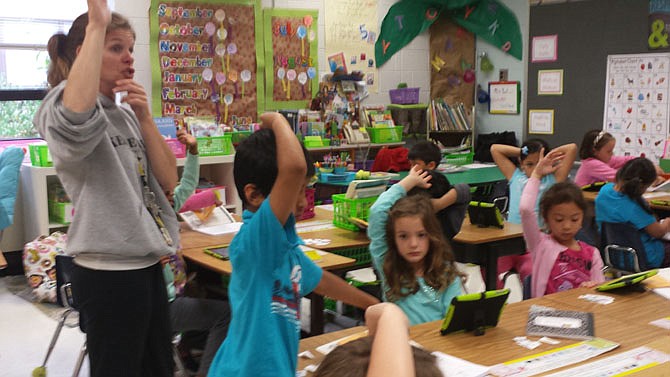Keene Mill Elementary School first grade teacher Sandi Yost gets the attention of her students as they transition to use an app called myON, an app that recommends books to students based on their interests, reading levels and ratings of others books they have read. Photos by Marissa Beale/The Connection
Tablets and iPads in the hands of 6-year-olds is not such an unusual sight anymore, and now these devices are being used in the classroom. At Keene Mill Elementary School, 60 iPads are in the hands of first and second grade students, and being used to “change the time, place and pace of learning.”
“It’s a challenge,” said Brian Lachance, technology specialist at Keene Mill Elementary who helped write the grant to bring the iPads to the school. “There are a lot of apps and possibilities.”
Before the start of the new school year, Fairfax County provided an opportunity for schools to apply for an innovation grant. Lachance and Annie Dipert, instructional coach at Keene Mill, both worked on the proposal for the school. “It’s not tied to any particular subject, and iPads are easy for first and second graders to tote around,” said Lachance.
BY JANUARY 2015 is when they hope that students will begin taking the devices home, but for right now Lachance and teachers are testing how well students use the iPads during the school day.
Students in Mindy Stewart’s second grade class spend about an hour each day, on average, using their iPads. “Twenty minutes here and twenty minutes there, for different subjects,” said Stewart. “My goal is to also increase their proficiency in tech tools. They troubleshoot and problem solve.” The students use their iPads for word study, science and math, and have the option to either type or write by hand.
When it was time for an activity called “Read to Self,” the more than two dozen second grade students in Stewart’s class reached into their desks and pulled out their iPads. They know how to turn on the devices and navigate around book, game and other activity selections. Using earphones, they each listened as different stories were read to them, which helps with improving reading and pronunciation skills.
“It’s great for ESOL kids to hear words and see them highlighted. It’s both auditory and visual, and the students can move at their own pace,” said Stewart. Students also have their own log-ins and have even recorded themselves reading and giving presentations. The plan is for all student work completed on the iPads to be placed into a Dropbox, an online file-sharing system, so that parents can access their child or children’s work online.
Lachance, who also screens the apps before students use them, receives grant training through the County. At this training, different schools meet and discuss ideas and progress with regards to classroom innovation. Keene Mill is one of about 20 different schools that meet for training. “Our goal with having students use these iPads is really for them to see that learning can take place anywhere, not just at school,” said Lachance. By next year, the school’s goal is for there to be around 10 iPads in all three of Keene Mill’s first and second grade classrooms. “They are willing to take risks,” said Stewart, referring to her students. “It’s a learning tool.” Furthermore, using the devices prepares these second grade students for online state testing, which takes place in the third grade.
In Sandi Yost’s first grade classroom, close to 30 students are reading, writing and drawing using their iPads. “We like our iPads. Our favorite thing to do is read books,” said first grade student Niyana Ghimai-Thomas and her friend and herself.
“My goal is to use less paper and pencil and find a way to integrate everything in the classroom,” said Yost. “Parents are thrilled and I feel very lucky to do this,” she continued. Students are not shy about sharing what they can do with their iPads. But in addition to turning them on and off, and navigating through different programs, each student also knows how to keep the device clean.
“You can do anything,” said first grade student Yousef Samghouli, proudly displaying work on his iPad. Sixty iPads in the hands of 30 first grade students and 30 second grade students to use on their own might sound like a crazy idea, but to the teachers and administrators at Keene Mill Elementary School, it was a novel one.
IN OCTOBER, Keene Mill Elementary School was also recognized as a model PLC School. They are one of about 200 schools and districts in the United States and Canada to receive this honor. A PLC, or Professional Learning Community school, is an institution that focuses on learning, building a collaborative culture and creating a results orientation. For complete list of model PLC schools, visit allthingsplc.info.


